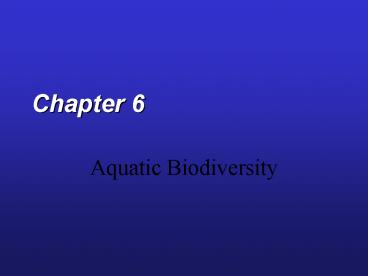Aquatic Biodiversity - PowerPoint PPT Presentation
1 / 23
Title:
Aquatic Biodiversity
Description:
Why Should We Care About Coral Reefs? Coral reefs form in clear, warm coastal waters of the tropics ... Dowitcher. Freshwater Inland Wetlands: Vital Sponges ... – PowerPoint PPT presentation
Number of Views:1159
Avg rating:3.0/5.0
Title: Aquatic Biodiversity
1
Chapter 6
- Aquatic Biodiversity
2
Saltwater Life Zones
- Coastal zone and Open Sea
- Estuaries-Salt and fresh water
- Coastal wetlands- Covered in water
- Mangroves-Salt tolerant trees
- Intertidal zones-Between tides.
- Coral Reefs
- Barrier islands-Low offshore islands
3
Ocean Zones
Dissolved Oxygen
Fig. 6-5
4
Fig. 6-1a, p. 126
5
Core Case StudyWhy Should We Care About Coral
Reefs?
- Coral reefs form in clear, warm coastal waters of
the tropics and subtropics. - Formed by massive colonies of polyps.
Figure 6-1
6
Core Case StudyWhy Should We Care About Coral
Reefs?
- Help moderate atmospheric temperature by removing
CO2 from the atmosphere. - Act as natural barriers that help protect 14 of
the worlds coastlines from erosion by battering
waves and storms. - Provide habitats for a variety of marine
organisms.
7
Fig. 6-7b, p. 131
8
Estuaries and Coastal Wetlands Centers of
Productivity
- Estuaries and coastal marshes provide ecological
and economic services. - Filter toxic pollutants, excess plant nutrients,
sediments, and other pollutants. - Reduce storm damage by absorbing waves and
storing excess water produced by storms and
tsunamis. - Provide food, habitats and nursery sites for many
aquatic species.
9
y
Herring gulls
Peregrine falcon
Snowy Egret
Cordgrass
Short-billed Dowitcher
Marsh Periwinkle
Phytoplankton
Smelt
Zooplankton and small crustaceans
Soft-shelled clam
Clamworm
Bacteria
Producer to primary consumer
All consumers and producers to decomposers
Secondary to higher-level consumer
Primary to secondary consumer
Fig. 6-7a, p. 131
10
Freshwater Inland Wetlands Vital Sponges
- Inland wetlands act like natural sponges that
absorb and store excess water from storms and
provide a variety of wildlife habitats.
Figure 6-18
11
Case StudyDams, Wetlands, Hurricanes, and New
Orleans
- Dams and levees have been built to control water
flows in New Orleans. - Reduction in natural flow has destroyed natural
wetlands. - Causes city to lie below sea-level (up to 3
meters). - Global sea levels have risen almost 0.3 meters
since 1900.
12
Mangrove Forests
Figure 6-8
13
What Kinds of Organisms Live in Aquatic Life
Zones?
- Aquatic systems contain floating, drifting,
swimming, bottom-dwelling, and decomposer
organisms. - Plankton important group of weakly swimming,
free-floating biota. - Phytoplankton (plant), Zooplankton (animal),
Ultraplankton (photosynthetic bacteria) - Necton fish, turtles, whales.
- Benthos bottom dwellers (barnacles, oysters).
- Decomposers breakdown organic compounds (mostly
bacteria).
14
Rocky and Sandy Shores Living with the Tides
- Organisms in intertidal zone develop specialized
niches to deal with daily changes in - Temperature
- Salinity
- Wave action
Figure 6-9
15
Barrier Islands
- Low, narrow, sandy islands that form offshore
from a coastline. - Primary and secondary dunes on gently sloping
sandy barrier beaches protect land from erosion
by the sea.
Figure 6-10
16
Human influences
- 40 of worlds population 62 miles of coast
- 53 of lower 48 wetlands lost
- 91 wetlands in Calif. Lost
- 35 of worlds mangroves
- 27worlds coral reefs damaged 11 destroyed By
2050 70 could be gone.
17
Freshwater Life Zones
Fig. 6-15
18
Types of Lakes Oligotrophic
19
Types of Lakes Eutrophic
20
Effects of Plant Nutrients on LakesToo Much of
a Good Thing
- Plant nutrients from a lakes environment affect
the types and numbers of organisms it can support.
Figure 6-16
21
River Systems
- Runoff
- Drainage basin
- Watershed
- Floodplain
Rain and snow
Source Zone
Fig. 6-17
22
Impacts of Human Activities on Freshwater Systems
- Dams, cities, farmlands, and filled-in wetlands
alter and degrade freshwater habitats. - Dams, diversions and canals have fragmented about
40 of the worlds 237 large rivers. - Flood control levees and dikes alter and destroy
aquatic habitats. - Cities and farmlands add pollutants and excess
plant nutrients to streams and rivers. - Many inland wetlands have been drained or filled
for agriculture or (sub)urban development.
23
Rachel Carson
- All at last returns to the sea-to Oceanus, the
ocean river, like the ever-flowing stream of
time, the beginning and the end. - End chapter 6































